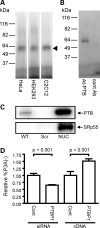Tannic acid facilitates expression of the polypyrimidine tract binding protein and alleviates deleterious inclusion of CHRNA1 exon P3A due to an hnRNP H-disrupting mutation in congenital myasthenic syndrome
- PMID: 19147685
- PMCID: PMC2655771
- DOI: 10.1093/hmg/ddp023
Tannic acid facilitates expression of the polypyrimidine tract binding protein and alleviates deleterious inclusion of CHRNA1 exon P3A due to an hnRNP H-disrupting mutation in congenital myasthenic syndrome
Abstract
We recently reported that the intronic splice-site mutation IVS3-8G>A of CHRNA1 that encodes the muscle nicotinic acetylcholine receptor alpha subunit disrupts binding of a splicing repressor, hnRNP H. This, in turn, results in exclusive inclusion of the downstream exon P3A. The P3A(+) transcript encodes a non-functional alpha subunit that comprises 50% of the transcripts in normal human skeletal muscle, but its functional significance remains undetermined. In an effort to search for a potential therapy, we screened off-label effects of 960 bioactive chemical compounds and found that tannic acid ameliorates the aberrant splicing due to IVS3-8G>A but without altering the expression of hnRNP H. Therefore, we searched for another splicing trans-factor. We found that the polypyrimidine tract binding protein (PTB) binds close to the 3' end of CHRNA1 intron 3, that PTB induces skipping of exon P3A and that tannic acid increases the expression of PTB in a dose-dependent manner. Deletion assays of the PTB promoter region revealed that the tannic acid-responsive element is between positions -232 and -74 from the translation initiation site. These observations open the door to the discovery of novel therapies based on PTB overexpression and to detecting possible untoward effects of the overexpression.
Figures




References
-
- Hagerman A.E. 2002. Tannin Chemistry http://www.users.muohio.edu/hagermae/
-
- Yam T.S., Hamilton-Miller J.M., Shah S. The effect of a component of tea (Camellia sinensis) on methicillin resistance, PBP2’ synthesis, and beta-lactamase production in Staphylococcus aureus. J. Antimicrob. Chemother. 1998;42:211–216. - PubMed
-
- Cozzolino D., Cynkar W.U., Dambergs R.G., Mercurio M.D., Smith P.A. Measurement of condensed tannins and dry matter in red grape homogenates using near infrared spectroscopy and partial least squares. J. Agric. Food Chem. 2008;56:7631–7636. - PubMed
Publication types
MeSH terms
Substances
Grants and funding
LinkOut - more resources
Full Text Sources
Other Literature Sources

